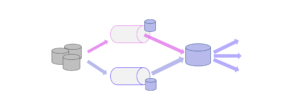In today’s Big Data era, Data Warehouse Systems and Data Science Analytics Infrastructures are crucial for organizations to store, analyze, and make informed decisions. With the advent of cloud computing, many are moving their Data Warehouse Systems to the cloud for enhanced scalability, flexibility, and cost-efficiency. Infrastructure as Code (IaC), which automates the provisioning and management of cloud resources through code, can significantly benefit the development and maintenance of cloud-based Data Warehouse Systems.
Using IaC for Cloud Data Infrastructures makes sense
Using Infrastructure as Code (IaC) for cloud resources like SQL databases and ETL tools in Data Warehouse Systems offers various advantages over manual setup via admin portals. It facilitates version control, allowing for tracking architecture changes over time, ensuring consistency, and easier issue identification. IaC enables efficient auto-scaling tailored to real-time data needs, promoting cost-efficiency by precisely controlling resource allocation. It streamlines collaboration among cross-functional teams by ensuring everyone works with the same configurations, reducing discrepancies across different environments. Additionally, IaC enhances security and compliance by automating and codifying security configurations, ensuring adherence to organizational and regulatory guidelines.
Especially the aspect of sustainability and reliability pays off: Manual configurations are prone to human error, which can compromise the reliability of a Data Warehouse System. IaC mitigates this risk by automating repetitive tasks, ensuring that the infrastructure is consistently provisioned. This brings reliability to data ETL (Extract, Transform, Load) processes, query performances, and other critical data operations. Furthermore IaC allows for swift disaster recovery by codifying the entire infrastructure. If a disaster occurs, the infrastructure can be quickly recreated, reducing downtime and data loss.
Which IaC solution do we at DATANOMIQ use?
The most common tools for creating Cloud Infrastructure as Code are probably Terraform and Pulumi. However, IaC solutions can be very different in their concepts. For example: While Terraform is a pure declarative configuration language that just describes how the infrastructure will look like (execution then by the Terraform-supporting Cloud Provider), Pulumi on the other hand will execute the deployment by a programming language iteratively deploying the wished cloud resources (e.g. using for loops in Python). While executing Pulumi in any supported programming language like Python or C#, Pulumi generates declarative Infrastructure build plans for the Cloud. Any IaC solution is declaring how the infrastrcture looks like, but the HOW for the developer might be quite different.
If no other negotiated, the DATANOMIQ team counts on Terraform which is one of the most widely used Infrastructure as Code (IaC) tools, developed by HashiCorp. It enables users to define and provision a data center infrastructure using a declarative configuration language known as HashiCorp Configuration Language (HCL).
Read more about why to use IaC for Cloud Data Warehouses and Data Lakes at the Data Science Blog.
 DATANOMIQ is the independent consulting and service partner for business intelligence, process mining and data science. We are opening up the diverse possibilities offered by big data and artificial intelligence in all areas of the value chain. We rely on the best minds and the most comprehensive method and technology portfolio for the use of data for business optimization.
DATANOMIQ is the independent consulting and service partner for business intelligence, process mining and data science. We are opening up the diverse possibilities offered by big data and artificial intelligence in all areas of the value chain. We rely on the best minds and the most comprehensive method and technology portfolio for the use of data for business optimization.




